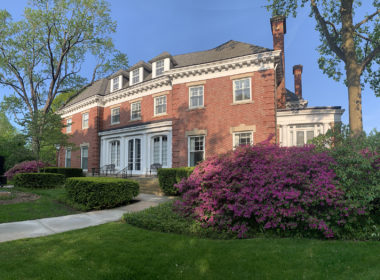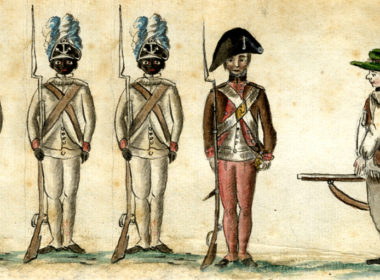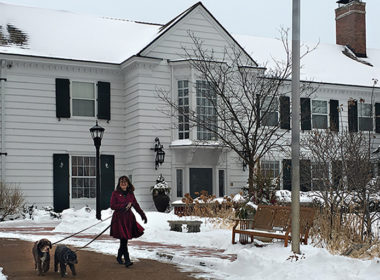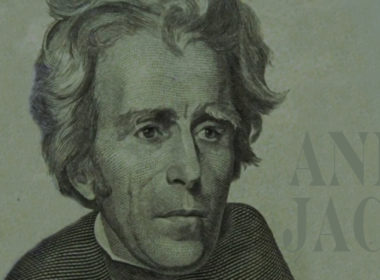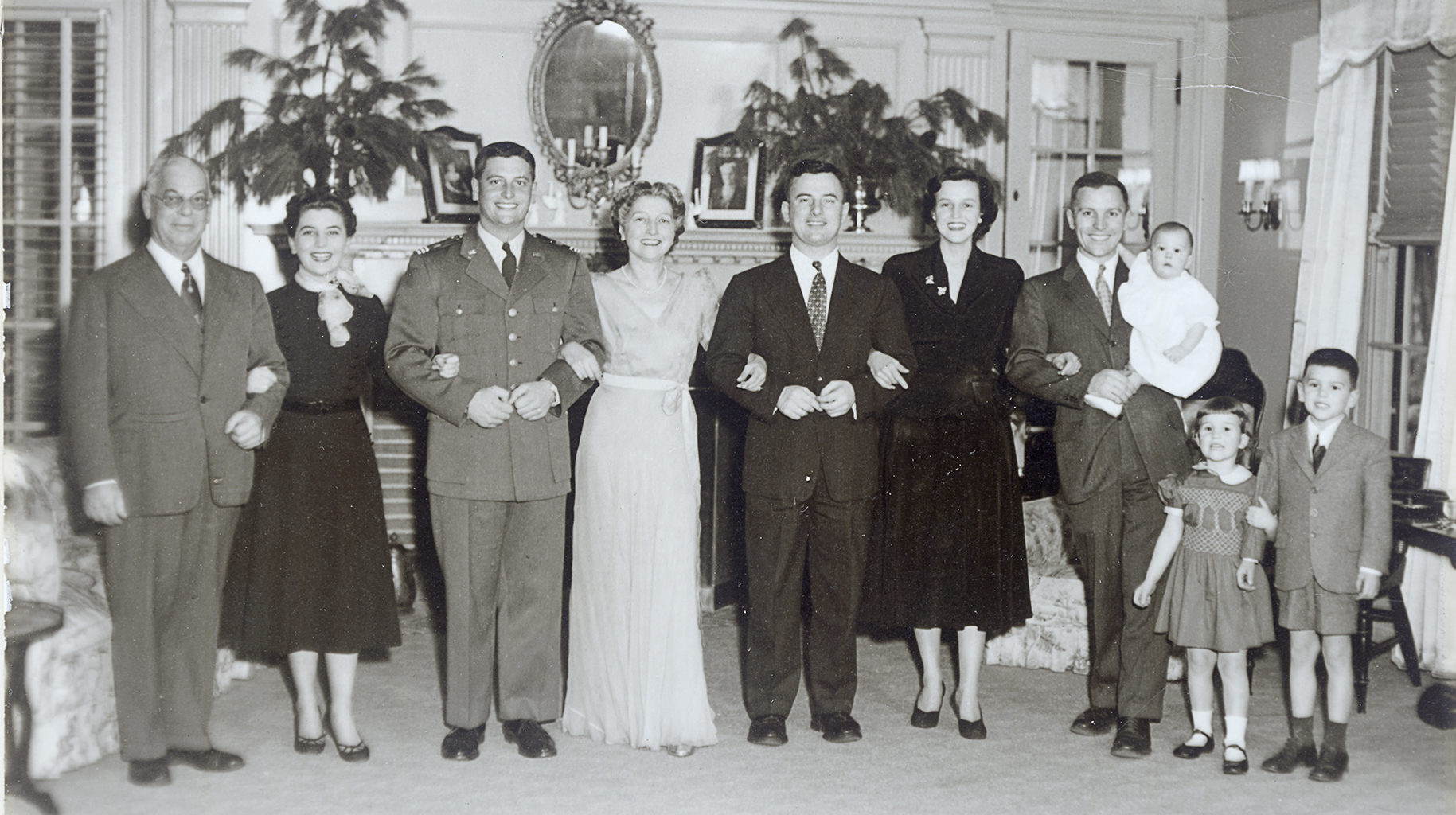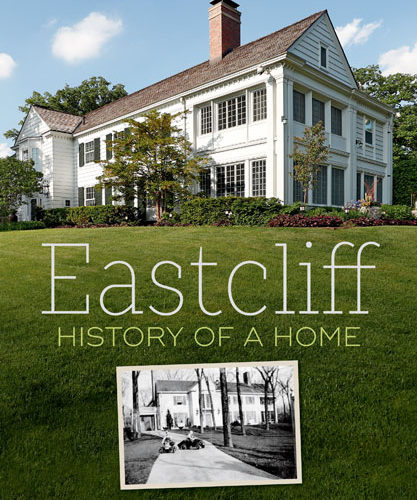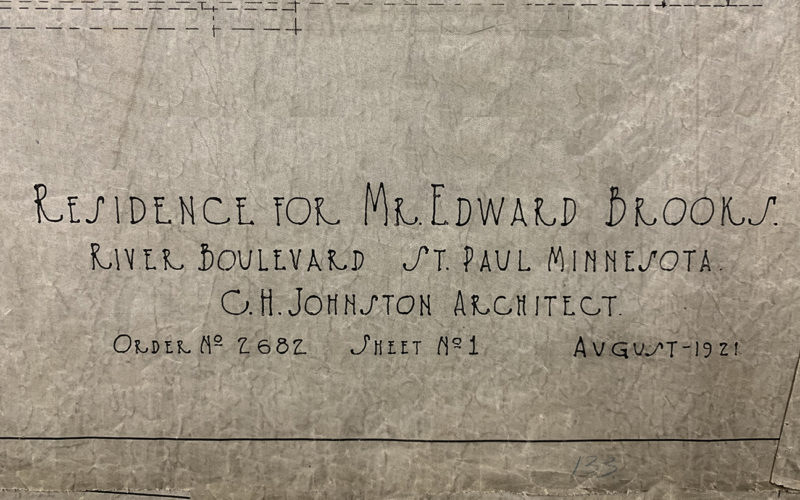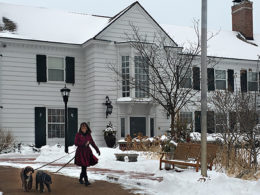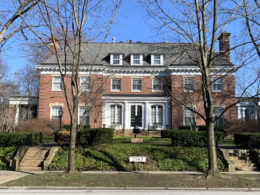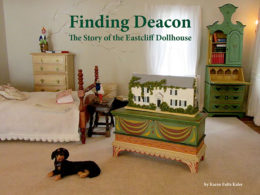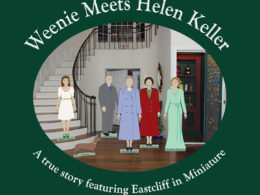Newspaper articles from the 1920s provide a glimpse into the lives of Edward and Markell Brooks and the early days of Eastcliff. Photographs and letters provide a more intimate view.
Most of the stories about the Brooks family in Eastcliff: History of a Home are from personal interviews or from a Brooks family history titled Turning the Leaves. Turning the Leaves was written in the early 1990s by Edward and Markell’s daughters-in-law, Marney Brooks and Ginny Brooks, with additional chapters written by each of the four Brooks children who grew up in the house.
I also searched through Brooks family files stored in the Minnesota Historical Society archives and old newspapers, both to confirm story details and enhance the recollections. A few of these documents and newspaper articles are shown below.
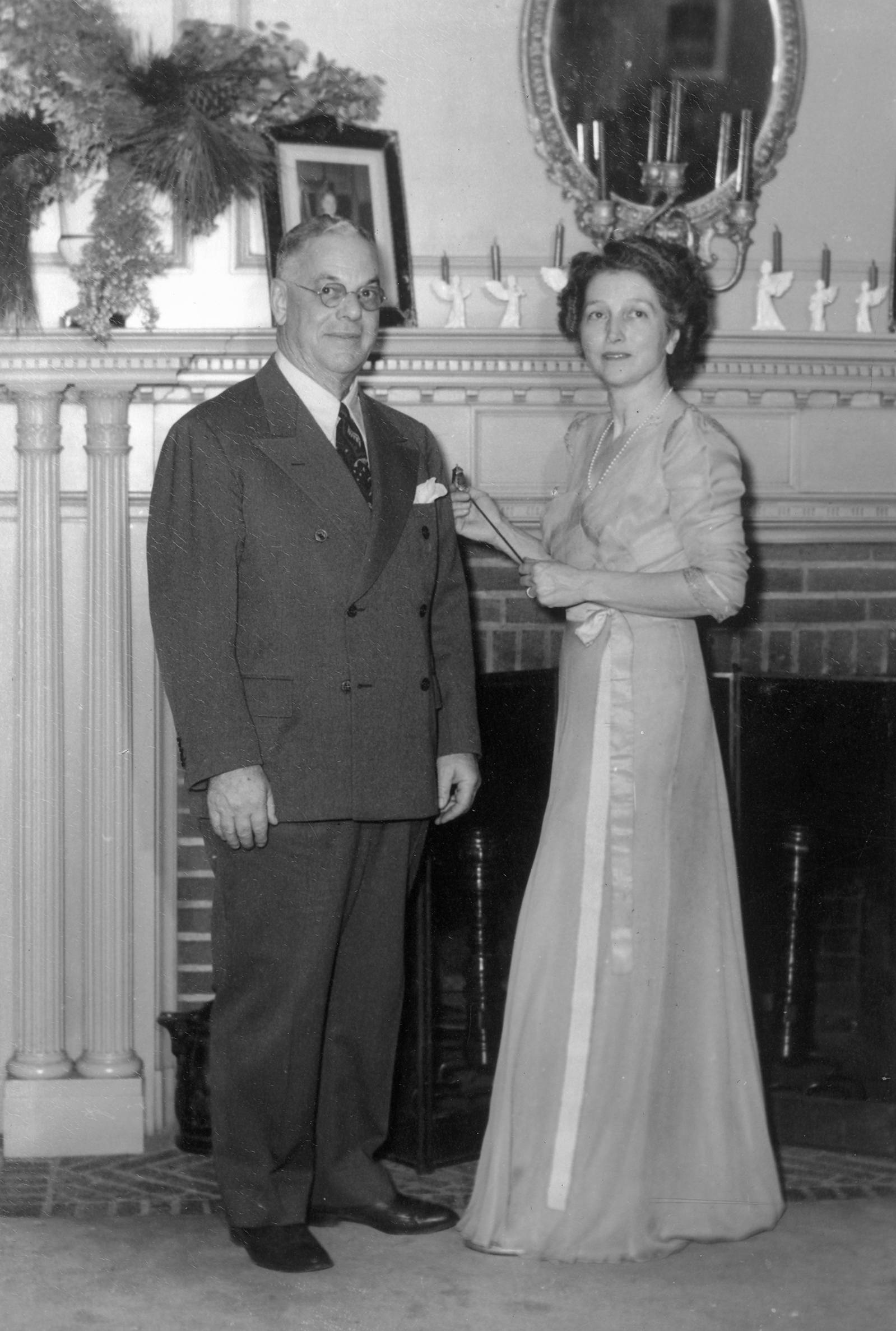
Regarding newspaper credit lines, please note that the Minneapolis Tribune began publication in 1867, and the Minneapolis Star in 1920. They consolidated in 1941 as morning (Tribune) and evening (Star) papers. In 1982, the evening paper was discontinued, and the morning paper became the Minneapolis Star and Tribune. The name was changed to the Star Tribune in 1987.
Photos are courtesy of the Brooks family.
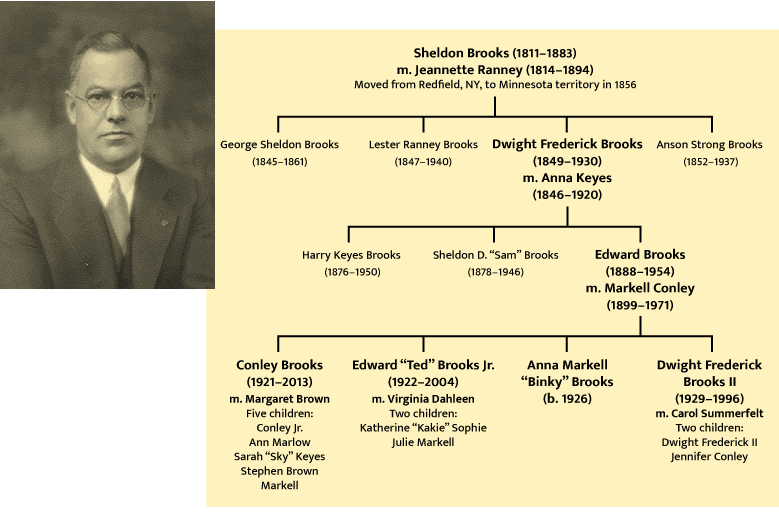
Edward Brooks grandfather, Sheldon Brooks (1811–1863), moved his family from Redfield, New York, to Minnesota. He wrote in his diary, “We suppose the Brookses (3 brothers) came from England in the 16–17th century, landed in Massachusetts and from thence have scattered all over the country.” Sheldon traced his ancestors to his great-great-grandfather, Jabez Brooks, born 1673 in Woburn, Massachusetts. Further family research established that Jabez was the grandson of Henry and Sarah Brooks, who immigrated to Massachusetts, from Suffolk, England.
Markell Conley was born January 9, 1899, to John Thomas Conley and Grace Hawkins Flower. Markell’s father, John Conley, emigrated from Ireland with his parents as an infant, and her mother, Grace Hawkins, had been adopted by her maternal aunt and uncle (becoming Grace Hawkins Flower).
Markell Conley’s birth certificate and announcement card were photographed by the author from the originals in “MARKELL CONLEY BROOKS: An Inventory of Her Genealogy Files” at the Minnesota Historical Society.
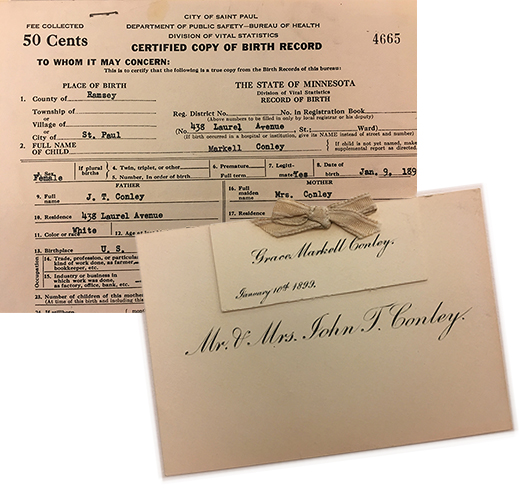
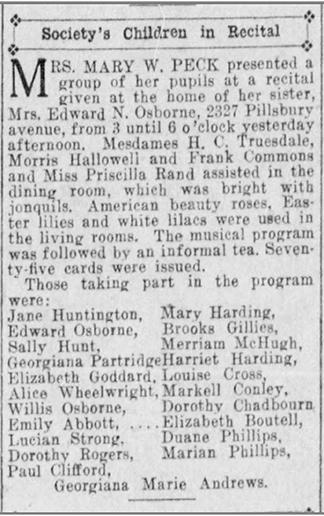
Searching through old Minneapolis newspapers, the first mention I found of Markell Conley was in 1911, when she was just twelve years old. Under a headline “Society’s Children in Recital” was a story of a three to six o’clock event that included a musical program followed by a tea. Markell Conley is one of the twenty-two girls listed as performing.
Minneapolis Tribune, March 12, 1911
By 1915, the year she turned sixteen, Markell’s family had moved to Chicago, and her visits to the Twin Cities were deemed newsworthy. She was in the society column four times that year, first as the guest of honor at a party given by Totten Heffelfinger. She was also mentioned as a guest of Alice Wheelwright and of Mabel Langdon, and as traveling with Dorothy Chadbourn and her mother. She was in Joan Orton’s 1919 wedding wearing a gown of deep orchid, with an ostrich feather in her hair and carrying a fan. Young women who visited her in Chicago were also mentioned in the paper. She was in the Minneapolis society column at least eight times before she married.
Markell attended Smith College, but left before graduating to marry Edward. The Chicago Tribune reported simply that the April 5, 1920, wedding was at eight o’clock at St. Chrysostom’s church.
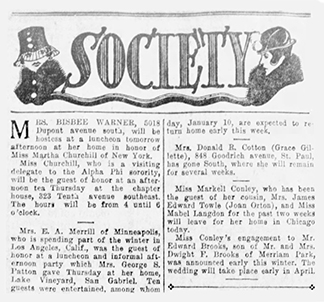
A Minneapolis newspaper reported the names of the attendants, as well as some of their travel plans prior to the wedding. The matron of honor was Mrs. James Towle (formerly Joan Orton, Markell’s cousin), the bridesmaids were Miss Mabel Langdon, Miss Frances Coonley of Chicago (her named was incorrectly spelled as Conley, after she married she was known as Frannie Underwood), and Miss Elizabeth Albright of Buffalo, NY. Best man was Mr. Samuel H. Bowman of St. Paul. Ushers were Mr. H. J. Simon, St. Paul; Mr. T. H. Culligan, St. Paul; Mr. H. K. Brooks, Bend, OR (Edward’s brother Harry); Mr. S. D. Brooks, Vancouver (Edward’s brother Sam). A small reception at the home of the bride’s parents followed the ceremony.
Minneapolis Tribune, January 27, 1920
Thirteen months after her wedding, Markell was pictured as one of ten young women and two girls who were attendants in the wedding of Mabel Langdon to Howard I. McMillan. The women are all carrying enormous bouquets, which would have concealed evidence that Markell was “with child.”
Minneapolis Tribune, May 1, 1921

The society column of the June 20, 1921, Minneapolis Morning Tribune gives a hint of how birth was regarded in Twin Cities society in the early 1920s when Markell Brooks gave birth: “Mrs. John T. Conley of Chicago, formerly of this city, is the guest of her son-in-law and daughter, Mr. and Mrs. Edward Brooks (Markell Conley) of Merriam Park.”
There was no mention that she might be visiting because her daughter was expecting her first child—Conley was born September 16, 1921.
The December 20, 1921, paper included the sentences, “Mrs. Edward Brooks (Markell Conley) left Sunday evening for Chicago, where she will spend the holidays with her mother, Mrs. E. C. Conley. Mr. Brooks will join Mrs. Brooks this week.” No mention of the infant.
The next society column I found with Markell’s name was on November 22, 1922: “Mrs. John P. Conley of Chicago is the guest of her son-in-law and daughter, Mr. and Mrs. Edward Brooks (Markell Conley) of Mississippi River Boulevard.” Again, no mention that Markell had given birth to her second child two weeks before. (Ted was born November 8, 1922.)
In the above text, Markell’s mother, Grace Hawkins Flower Conley, was referred to as “Mrs. John T. Conley,” “Mrs. E. C. Conley,” and Mrs. John P. Conley.” Markell’s father’s name was John Thomas Conley, so the first reference is the correct one. Markell’s father’s funeral was held at Eastcliff on June 24, 1935. The only survivors listed were Markell and her brother.
While Markell’s name appeared in the society columns as a young woman, and the couple were mentioned in society news, the parties they gave were private and not in the news. I only found two exceptions:
Minneapolis Star, June 10, 1927: “Mrs. Edward Brooks of ‘Eastcliff,’ Mississippi Boulevard, will give a luncheon Wednesday afternoon for Miss Emmy Lou Weed, daughter of Mr. and Mrs. Paul C. Weed, whose marriage to Cecil Read will take place June 23.” This type of “Miss Weed marries Mr. Read” article is the stock-in-trade of society news.
Minneapolis Star, June 20, 1928: “Mrs. Edward Brooks (Markell Conley) of Mississippi River boulevard will be a hostess to a group of the younger matrons from the Twin Cities at dinner this evening in her home.” Markell herself was 29 years old at this time, but I’m unsure from the wording here if the dinner was for other younger matrons such as herself, or if, at age 29, she was considered an older matron.
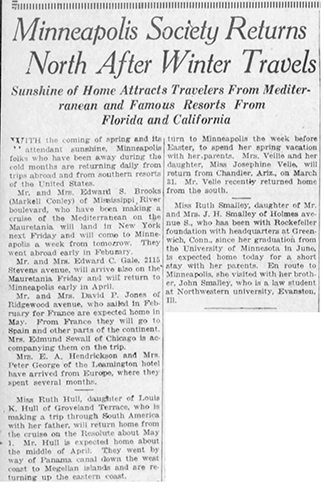
Markell and Edward were mentioned in a society news column in 1925 as being on a Mediterranean cruise on the Mauretania. This column regarding prominent Minneapolitans understandably fails to mention that Edward and Markell lived in St. Paul. Curiously, this is the only time I found a reference to a middle initial for Edward (Edward S. Brooks). The family history never mentions a middle name, nor do any other newspaper articles, including his obituary, nor is there a middle initial ever used for Edward Jr. (In one of Edward’s diaries, from 1907, he wrote “Edward R. Brooks.”)
The Minneapolis Star, March 28, 1925
Edward didn’t have, or need, a birth certificate until 1940 when he was fifty-two years old. At that time, it became necessary to have a birth certificate to travel to Vancouver on business. (Edward’s doctor father attended to his birth at home, and registering births was not required at that time.) Contemporary passport use began in the US in 1941.
A 1932 article described the destruction of the Gates Mansion, which may have been significant in the gift of Eastcliff to the University of Minnesota (see Eastcliff: History of a Home).
Minneapolis Star, December 29, 1932

A few other newspaper stories of interest included a society column in the March 20, 1934, Minneapolis Star regarding the St. Paul School of Art annual meeting stated that Markell was joining “Mrs. D. Grinnell Noyes, former wife of C. Reinold Noyes” at the speakers table, along with artists Clement Haupers and Cameron Booth. It was noted that Mr. and Mrs. Brooks “have just returned from a six weeks’ European tour.”
A 1944 article that included a description of Edward speaking in a business setting: “Lumberman Edward Brooks was quite dramatic when he pointed out some of the wonderful new developments from laminated wood: ‘And just to think,’ he said, ‘that the whole course of the lumber industry was revolutionized by what you can get in a little 10 cent bottle of glue.’ And he’ll stick to that story.”
The Minneapolis Star, September 15, 1944, Page 23
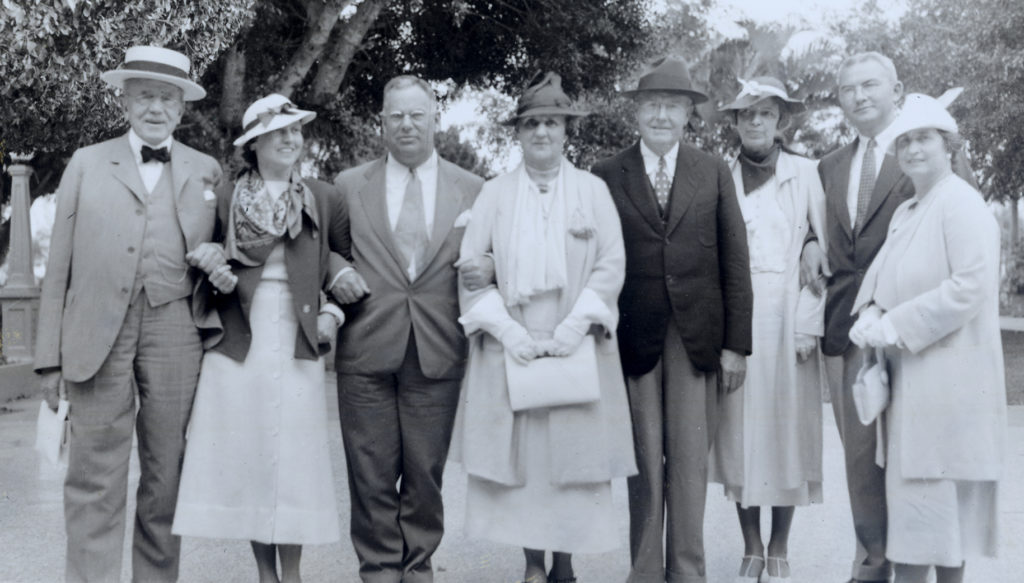
The Brooks enjoyed international travel, and Markell enjoyed volunteering with the International Institute of Minnesota. (The International Institute was founded in 1919 to provide support services to immigrant women and their families. They began their “Festival of Nations” event in 1932.) Markell was particularly active with the Institute and with the Red Cross in the 1940s, when her two older sons were in the service during WWII. Markell’s respect for those from other countries was passed down to her children. I have heard both Binky, in person, and Ted, on videotape, use the term “universal” as a sincere compliment for Markell and Dwight, in the examples I heard, as a person who is appreciative of different cultures.
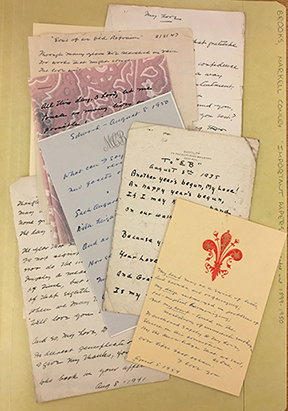
The Brooks archive in the Minnesota Historical Society contains Markell’s thin file folder labelled “Important Papers,” which includes her birth certificate, her marriage certificate, and love letters to her husband written on his birthdays in 1935, 1939, 1941, 1947, and 1954.
Photographed by the author from the originals in the file “MARKELL CONLEY BROOKS: An Inventory of Her Genealogy Files” at the Minnesota Historical Society
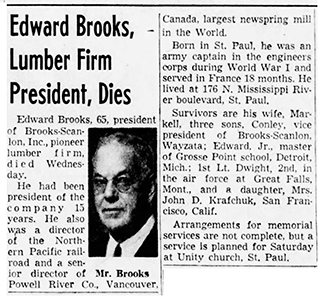
Edward Brooks died from a heart attack in December 1954. He had experienced his first heart attack in April of that year, shortly before Binky’s wedding. He was well enough that autumn that he and Markell went to Conley and Marney’s house for Thanksgiving, but he died ten days later.
There were, of course, no bypass operations in those days. The world’s first successful open-heart surgery was performed by Dr. F. John Lewis at the University of Minnesota in 1952. As mentioned in Eastcliff: History of a Home, Edward’s father was a doctor and Edward was very interested in medicine. According to his son, Ted (in a 1998 interview filmed at Eastcliff), “Over the years, one of my father’s very closest friends was Arthur Strachauer, who was a professor of surgery at the University and Owen Wangenstein’s predecessor as Chief of Surgery at the University. Dr. Strachauer was a man who my father worshipped, in part because he was a great surgeon and in part because he was just a wonderful man.”
Dr. Arthur Strachauer attended Minneapolis Central High School, entered the University of Minnesota as an undergraduate student in 1901. He graduated from the Medical School of the University of Minnesota in 1908. The program from Dr. Strachauer’s 1908 commencement (the University’s thirty-sixth annual commencement) is available in the University’s digital conservancy, a lovely thing to stumble upon.
The first successful heart bypass surgery was performed in 1960, after both Mr. Brooks and Dr. Strachauer had died.
Please note: The above text was edited from Eastcliff: History of a Home due to lack of space. It is intended as a supplement to the book.

